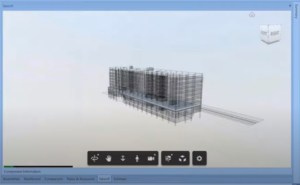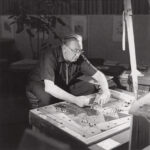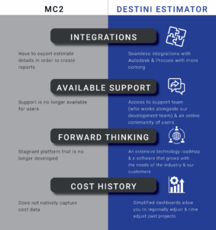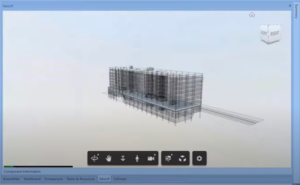Rebels of Construction—Charles M. Eastman
Without Charles (Chuck) M. Eastman’s—The Father of BIM—innovative spirit and tenacity—not only would Beck Technology not be the same, maybe not even exist, but even the entire AEC industry wouldn’t be where it is today. Chuck didn’t just develop the first centralized, integrated computerized database for architects to sort and retrieve information, he pioneered the way for owners and contractors to collaborate and work more efficiently than ever.
 Chuck Eastman, the father of BIM, wrote the BIM Handbook.
Chuck Eastman, the father of BIM, wrote the BIM Handbook.
Chuck’s theory, published in his 1975 paper, “The Use of Computers Instead of Drawings in Building Design,” described a computer program that would be able to perform parametric design and 3D representations. He called it Building Description System (BDS), a “single integrated database for visual and quantitative analyses,” stating that this theory in practice could cut design costs by 50 percent while making the construction design process more efficient.
Today, it seems inconceivable that you would have to draw—by hand—and then create an actual, scaled-down physical 3D model—by hand—during the preconstruction process. Chuck wrote, “The primary use of drawings in building is to depict the spatial composition of materials and spaces. Ancillary information regarding materials and spaces can be provided through notes and tables appended to the drawings. In this light, drawings have no intrinsic value in architecture, but are only the most useful existing device for the representation of building spatial information in a form convenient for decision making.” He pointed out that one of the earliest pitfalls of the construction process was the cost of data preparation and analysis and that both drawings and models needed multiple copies to provide accurate information throughout the design process.
His solution? The BDS:
“It would combine the positive aspects of both drawings and models and eliminate their common weaknesses. It would incorporate three-dimensional information in an easy-to-read format and would require any change to be made only once for its full effects to be revealed. It would accept changes easily and provide automatic checking for spatial conflicts. It would be portable and reproducible and would facilitate numerical analyses. A single description would be sufficient to allow measurements at any scale.”
And that my friends, is the first description of what is now Building Information Modeling. He called it Building Description System (BDS) and Building Product Modeling. Chuck created It but it wasn’t until 2002, when Beck Technology industry partner, Autodesk, and others began to standardize the term Building Information Modeling—BIM.
BIM has given us a digital visual representation of the building process, allowing for owners, architects, engineers, and contractors to easily communicate changes and find issues to make intelligent decisions. Seventy-three percent of companies that use BIM report shorter project lifecycles, save money on materials, reduce risk, and experience higher productivity. (NBS 10th National BIM Report 2020)
In 1977, Chuck began developing many of the primary features of what BIM is now. He called it GLIDE (Graphical Language for Interactive Design), describing it as “an attempt to organize commonly-needed database features and operations for the design of physical systems into a high-level computer environment.” He emphasized the need for 3D objects and the capability of their spatial arrangement in the program. Like Beck Technology’s construction estimating software, Chuck was not only developing a system that made the preconstruction process easier, he intentionally set out to create a process that prevents information loss, provides higher quality work, is much faster, integrates, and holds one centralized and standardized database, resulting in saving on costs and aid in much better planning during the preconstruction and construction data lifecycle. To read Chuck’s paper on the subject, click here.
Chuck gathered up his knowledge about design computation and created Formtek, a CAD company, in the early 1980s. He sold his computer-aided design company to Lockheed Martin in the latter part of that decade and then joined Georgia Tech’s faculty. He taught numerous students who went on to continue the work he laid the foundation for in combining the power of computers with design. Chuck also continued his research and brought together the smartest minds to think about a future where computer programming would remove inefficiencies in our processes.
Beck Technology President Stewart Carroll had the pleasure of knowing Chuck. Stewart says, “I instantly respected Chuck. He was one of the founders of the research that led to 3D technology, parametric modeling, and looking at how do you use these 3D models to make better decisions around both quantitative and qualitative measures.”
 Beck Technology's construction estimating software, DESTINI Estimator integrates with Autodesk BIM 360.
Beck Technology's construction estimating software, DESTINI Estimator integrates with Autodesk BIM 360.
Stewart worked alongside Chuck for about three years when Beck Technology was involved in providing the technology for the General Services Administration (GSA) and Chuck and his team was developing code checking approaches in the planning of courthouse buildings’ hallways, entry, and exit points to ensure the separation of public and non-public spaces.
Along with his research and design, Chuck taught at the University of Wisconsin, UCLA, Georgia Tech, and Carnegie-Mellon, where he founded their Ph.D. program in Architecture. In 1981, he founded the Association for Computer-Aided Design In Architecture (ACADIA). He retired in 2018 from Georgia Tech and died on November 9, 2020.
While at Georgia Tech, Chuck founded the Digital Building Laboratory in 2009 which develops disruptive technology that advances the AEC industry with four research tracks—data standards and interoperability; design, fabrication, and construction automation; project delivery systems; and smart buildings and infrastructure.
All of Chuck’s ideas were turning points in how architects, engineers, and estimators perform their job. He devoted his professional life to improving the building process from conception to completion. Beck Technology will continue to draw inspiration from a man who genuinely cared about the growth and efficiency of the AEC industry.
This post is part two of our series titled “Rebels of Construction.”
What Does it Mean to be a Rebel?
Rebels challenge conventional ways of thinking, defy rules, and rise up against those that tell them ‘no.’ Without Rebels, there would be no invention, innovation, or improvement in our society. Disrupting the status quo, a true Rebel charts a new course where all benefit. In the blog series, Rebels of Construction, Beck Technology celebrates the independent spirit of the Rebel.
Click the pictures below to read more on this series.

-1.png?width=112&height=112&name=image%20(4)-1.png)
















